Strategic Management: Components, Analysis, and Planning
VerifiedAdded on 2022/10/31
|8
|1232
|388
Report
AI Summary
This report provides a comprehensive analysis of the strategic management process. It begins by defining the key components of strategic management, including goal setting, analysis, strategy formulation, implementation, and control and evaluation. The report then delves into internal and external analysis, highlighting the importance of assessing an organization's strengths, weaknesses, opportunities, and threats (SWOT). It also discusses the responsibilities and duties of a strategic manager, emphasizing their role in developing corporate strategies and ensuring competitive advantages. Furthermore, the report explains the necessity of strategic management planning for companies, outlining its benefits such as providing direction, enhancing efficiency, and improving profitability. The report concludes by referencing key academic sources to support its findings, offering a robust understanding of strategic management principles.

Running head: MANAGEMENT
Strategic Planning and Strategic Management
Name of the Student:
Name of the University:
Author Note:
Strategic Planning and Strategic Management
Name of the Student:
Name of the University:
Author Note:
Paraphrase This Document
Need a fresh take? Get an instant paraphrase of this document with our AI Paraphraser
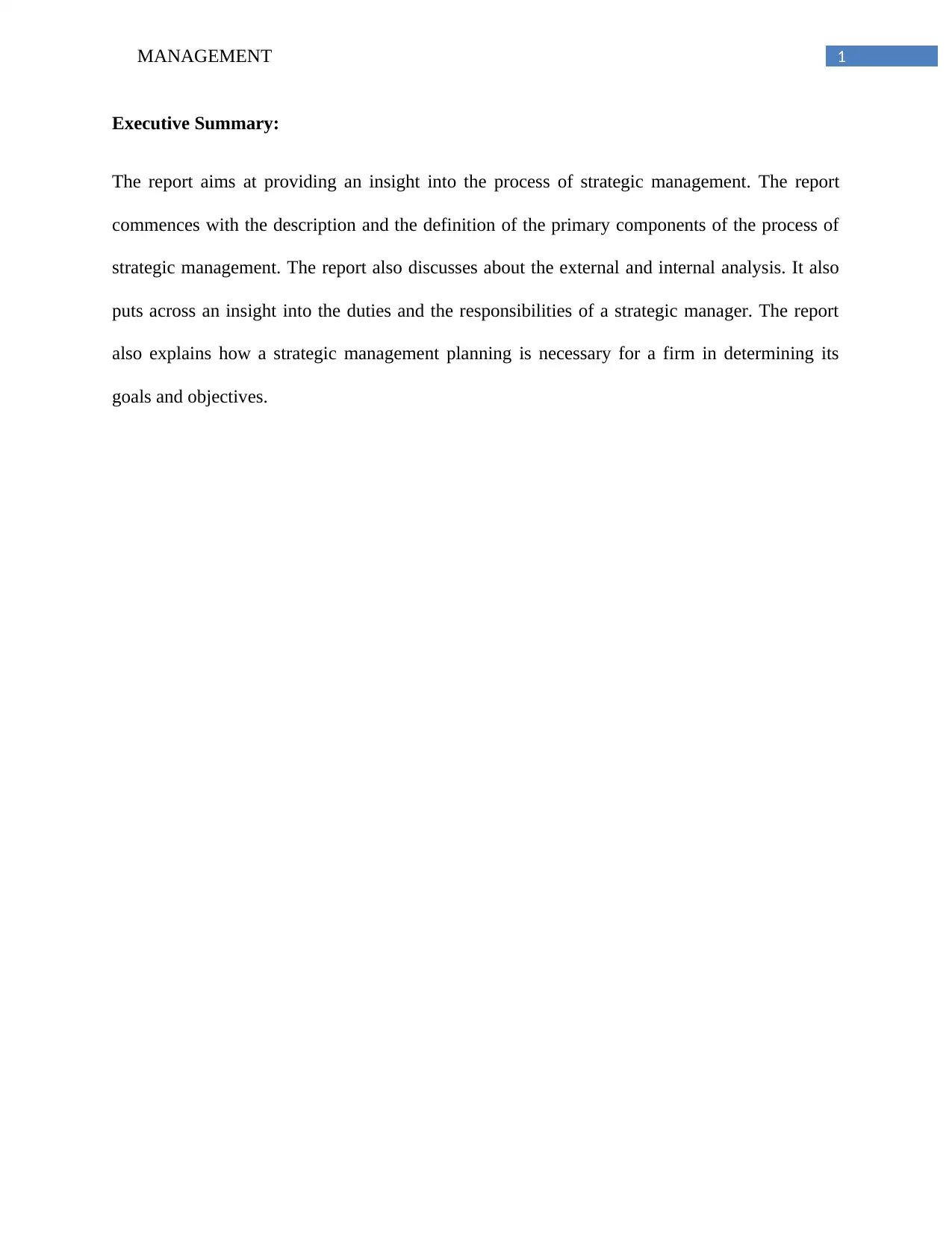
1MANAGEMENT
Executive Summary:
The report aims at providing an insight into the process of strategic management. The report
commences with the description and the definition of the primary components of the process of
strategic management. The report also discusses about the external and internal analysis. It also
puts across an insight into the duties and the responsibilities of a strategic manager. The report
also explains how a strategic management planning is necessary for a firm in determining its
goals and objectives.
Executive Summary:
The report aims at providing an insight into the process of strategic management. The report
commences with the description and the definition of the primary components of the process of
strategic management. The report also discusses about the external and internal analysis. It also
puts across an insight into the duties and the responsibilities of a strategic manager. The report
also explains how a strategic management planning is necessary for a firm in determining its
goals and objectives.
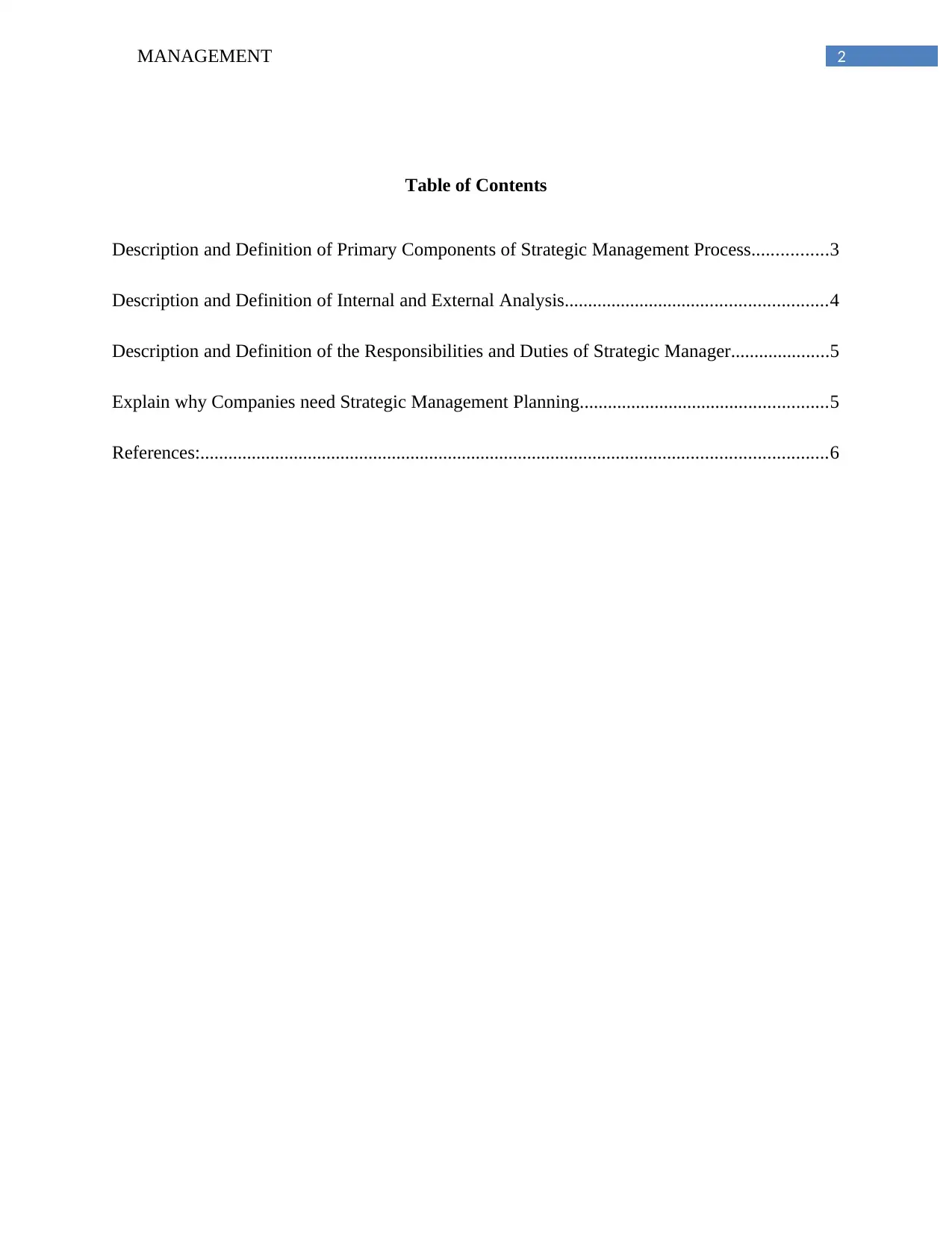
2MANAGEMENT
Table of Contents
Description and Definition of Primary Components of Strategic Management Process................3
Description and Definition of Internal and External Analysis........................................................4
Description and Definition of the Responsibilities and Duties of Strategic Manager.....................5
Explain why Companies need Strategic Management Planning.....................................................5
References:......................................................................................................................................6
Table of Contents
Description and Definition of Primary Components of Strategic Management Process................3
Description and Definition of Internal and External Analysis........................................................4
Description and Definition of the Responsibilities and Duties of Strategic Manager.....................5
Explain why Companies need Strategic Management Planning.....................................................5
References:......................................................................................................................................6
⊘ This is a preview!⊘
Do you want full access?
Subscribe today to unlock all pages.

Trusted by 1+ million students worldwide
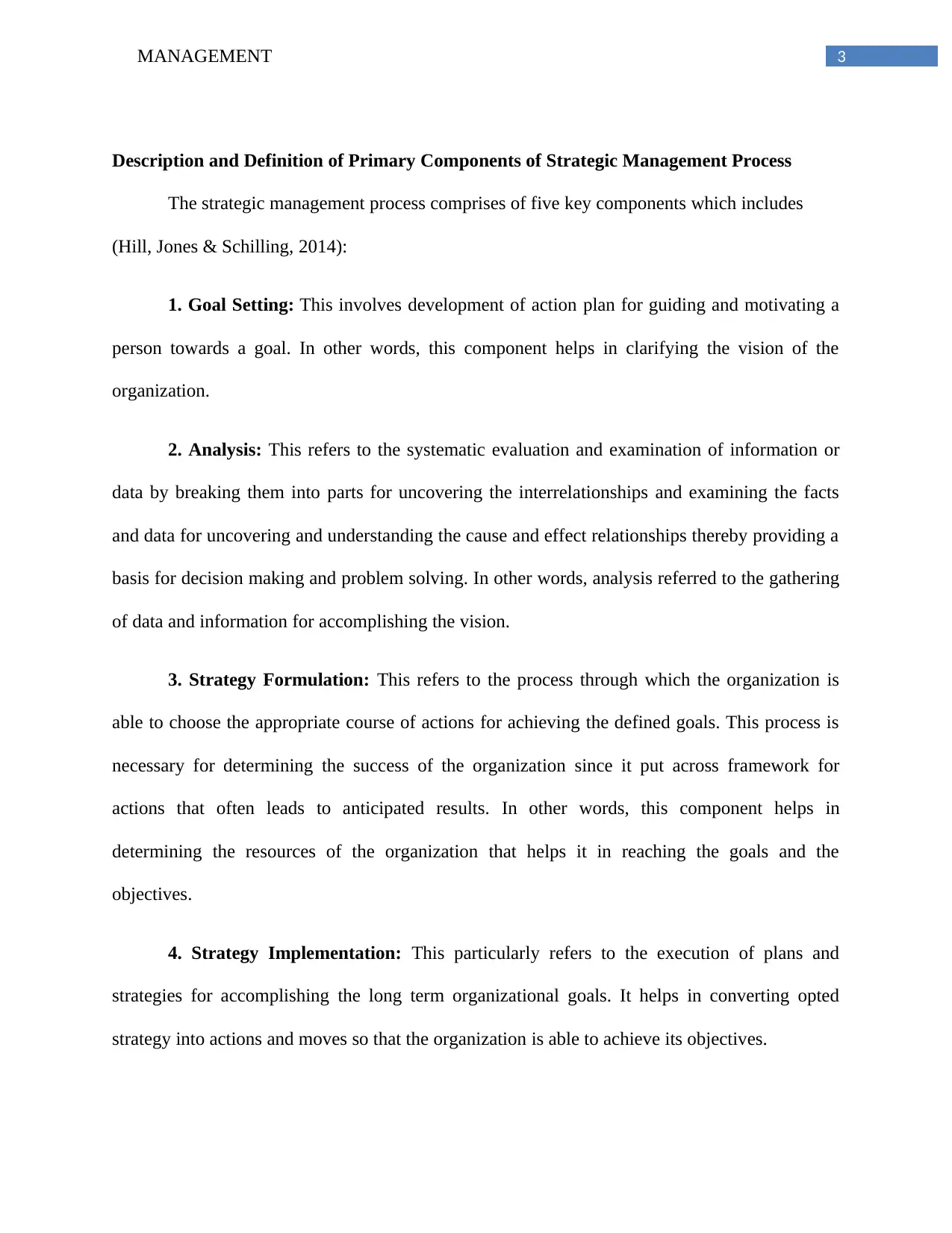
3MANAGEMENT
Description and Definition of Primary Components of Strategic Management Process
The strategic management process comprises of five key components which includes
(Hill, Jones & Schilling, 2014):
1. Goal Setting: This involves development of action plan for guiding and motivating a
person towards a goal. In other words, this component helps in clarifying the vision of the
organization.
2. Analysis: This refers to the systematic evaluation and examination of information or
data by breaking them into parts for uncovering the interrelationships and examining the facts
and data for uncovering and understanding the cause and effect relationships thereby providing a
basis for decision making and problem solving. In other words, analysis referred to the gathering
of data and information for accomplishing the vision.
3. Strategy Formulation: This refers to the process through which the organization is
able to choose the appropriate course of actions for achieving the defined goals. This process is
necessary for determining the success of the organization since it put across framework for
actions that often leads to anticipated results. In other words, this component helps in
determining the resources of the organization that helps it in reaching the goals and the
objectives.
4. Strategy Implementation: This particularly refers to the execution of plans and
strategies for accomplishing the long term organizational goals. It helps in converting opted
strategy into actions and moves so that the organization is able to achieve its objectives.
Description and Definition of Primary Components of Strategic Management Process
The strategic management process comprises of five key components which includes
(Hill, Jones & Schilling, 2014):
1. Goal Setting: This involves development of action plan for guiding and motivating a
person towards a goal. In other words, this component helps in clarifying the vision of the
organization.
2. Analysis: This refers to the systematic evaluation and examination of information or
data by breaking them into parts for uncovering the interrelationships and examining the facts
and data for uncovering and understanding the cause and effect relationships thereby providing a
basis for decision making and problem solving. In other words, analysis referred to the gathering
of data and information for accomplishing the vision.
3. Strategy Formulation: This refers to the process through which the organization is
able to choose the appropriate course of actions for achieving the defined goals. This process is
necessary for determining the success of the organization since it put across framework for
actions that often leads to anticipated results. In other words, this component helps in
determining the resources of the organization that helps it in reaching the goals and the
objectives.
4. Strategy Implementation: This particularly refers to the execution of plans and
strategies for accomplishing the long term organizational goals. It helps in converting opted
strategy into actions and moves so that the organization is able to achieve its objectives.
Paraphrase This Document
Need a fresh take? Get an instant paraphrase of this document with our AI Paraphraser
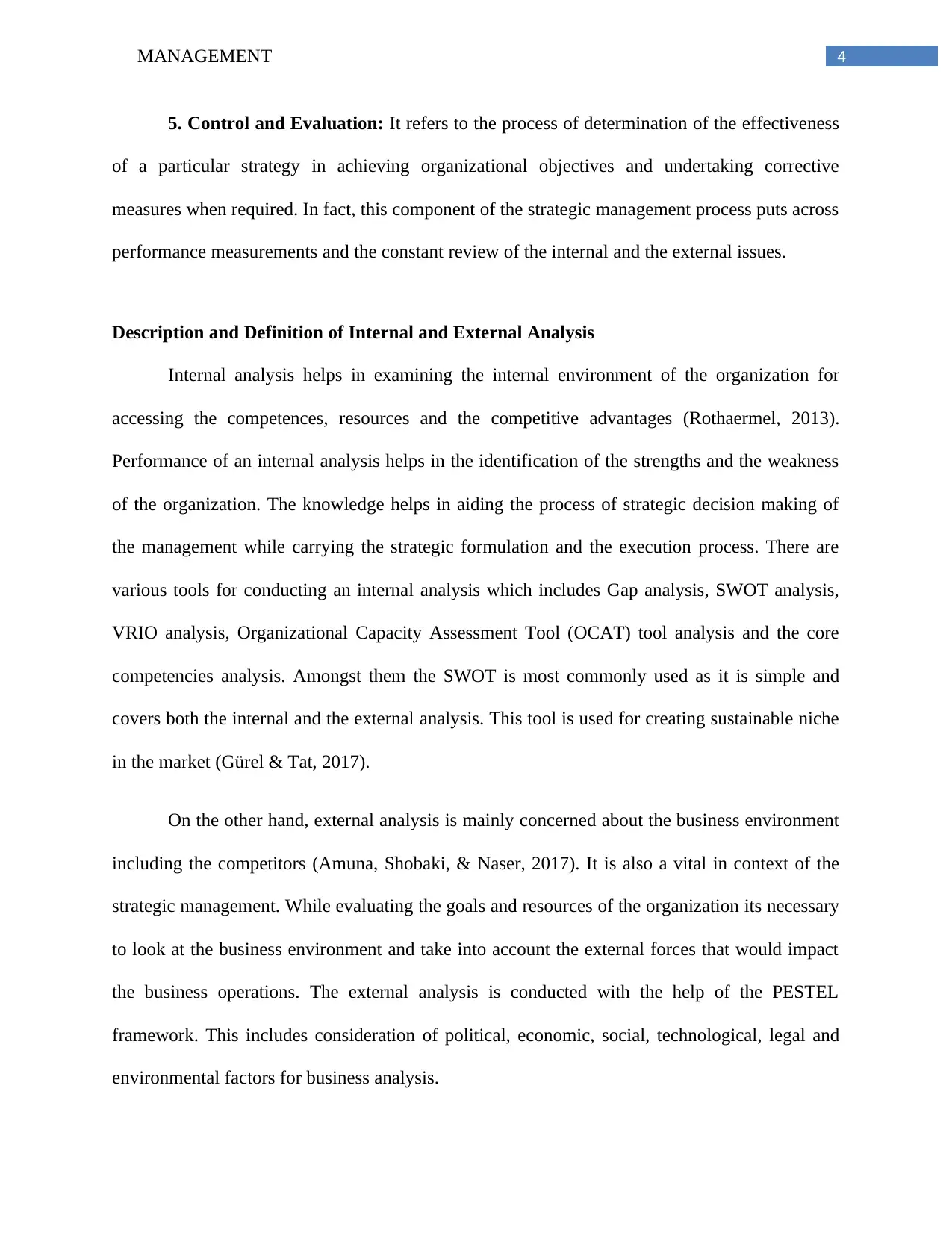
4MANAGEMENT
5. Control and Evaluation: It refers to the process of determination of the effectiveness
of a particular strategy in achieving organizational objectives and undertaking corrective
measures when required. In fact, this component of the strategic management process puts across
performance measurements and the constant review of the internal and the external issues.
Description and Definition of Internal and External Analysis
Internal analysis helps in examining the internal environment of the organization for
accessing the competences, resources and the competitive advantages (Rothaermel, 2013).
Performance of an internal analysis helps in the identification of the strengths and the weakness
of the organization. The knowledge helps in aiding the process of strategic decision making of
the management while carrying the strategic formulation and the execution process. There are
various tools for conducting an internal analysis which includes Gap analysis, SWOT analysis,
VRIO analysis, Organizational Capacity Assessment Tool (OCAT) tool analysis and the core
competencies analysis. Amongst them the SWOT is most commonly used as it is simple and
covers both the internal and the external analysis. This tool is used for creating sustainable niche
in the market (Gürel & Tat, 2017).
On the other hand, external analysis is mainly concerned about the business environment
including the competitors (Amuna, Shobaki, & Naser, 2017). It is also a vital in context of the
strategic management. While evaluating the goals and resources of the organization its necessary
to look at the business environment and take into account the external forces that would impact
the business operations. The external analysis is conducted with the help of the PESTEL
framework. This includes consideration of political, economic, social, technological, legal and
environmental factors for business analysis.
5. Control and Evaluation: It refers to the process of determination of the effectiveness
of a particular strategy in achieving organizational objectives and undertaking corrective
measures when required. In fact, this component of the strategic management process puts across
performance measurements and the constant review of the internal and the external issues.
Description and Definition of Internal and External Analysis
Internal analysis helps in examining the internal environment of the organization for
accessing the competences, resources and the competitive advantages (Rothaermel, 2013).
Performance of an internal analysis helps in the identification of the strengths and the weakness
of the organization. The knowledge helps in aiding the process of strategic decision making of
the management while carrying the strategic formulation and the execution process. There are
various tools for conducting an internal analysis which includes Gap analysis, SWOT analysis,
VRIO analysis, Organizational Capacity Assessment Tool (OCAT) tool analysis and the core
competencies analysis. Amongst them the SWOT is most commonly used as it is simple and
covers both the internal and the external analysis. This tool is used for creating sustainable niche
in the market (Gürel & Tat, 2017).
On the other hand, external analysis is mainly concerned about the business environment
including the competitors (Amuna, Shobaki, & Naser, 2017). It is also a vital in context of the
strategic management. While evaluating the goals and resources of the organization its necessary
to look at the business environment and take into account the external forces that would impact
the business operations. The external analysis is conducted with the help of the PESTEL
framework. This includes consideration of political, economic, social, technological, legal and
environmental factors for business analysis.
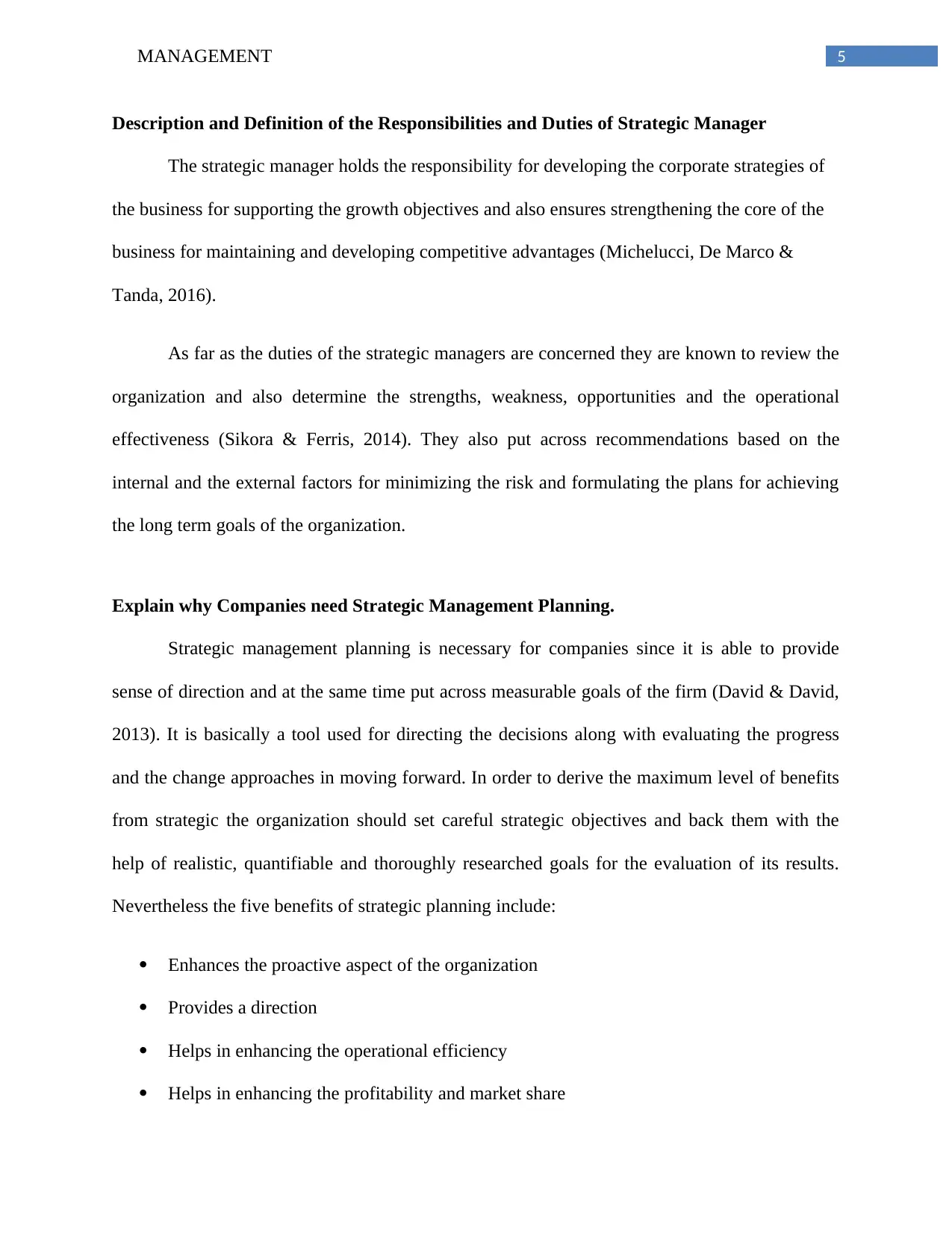
5MANAGEMENT
Description and Definition of the Responsibilities and Duties of Strategic Manager
The strategic manager holds the responsibility for developing the corporate strategies of
the business for supporting the growth objectives and also ensures strengthening the core of the
business for maintaining and developing competitive advantages (Michelucci, De Marco &
Tanda, 2016).
As far as the duties of the strategic managers are concerned they are known to review the
organization and also determine the strengths, weakness, opportunities and the operational
effectiveness (Sikora & Ferris, 2014). They also put across recommendations based on the
internal and the external factors for minimizing the risk and formulating the plans for achieving
the long term goals of the organization.
Explain why Companies need Strategic Management Planning.
Strategic management planning is necessary for companies since it is able to provide
sense of direction and at the same time put across measurable goals of the firm (David & David,
2013). It is basically a tool used for directing the decisions along with evaluating the progress
and the change approaches in moving forward. In order to derive the maximum level of benefits
from strategic the organization should set careful strategic objectives and back them with the
help of realistic, quantifiable and thoroughly researched goals for the evaluation of its results.
Nevertheless the five benefits of strategic planning include:
Enhances the proactive aspect of the organization
Provides a direction
Helps in enhancing the operational efficiency
Helps in enhancing the profitability and market share
Description and Definition of the Responsibilities and Duties of Strategic Manager
The strategic manager holds the responsibility for developing the corporate strategies of
the business for supporting the growth objectives and also ensures strengthening the core of the
business for maintaining and developing competitive advantages (Michelucci, De Marco &
Tanda, 2016).
As far as the duties of the strategic managers are concerned they are known to review the
organization and also determine the strengths, weakness, opportunities and the operational
effectiveness (Sikora & Ferris, 2014). They also put across recommendations based on the
internal and the external factors for minimizing the risk and formulating the plans for achieving
the long term goals of the organization.
Explain why Companies need Strategic Management Planning.
Strategic management planning is necessary for companies since it is able to provide
sense of direction and at the same time put across measurable goals of the firm (David & David,
2013). It is basically a tool used for directing the decisions along with evaluating the progress
and the change approaches in moving forward. In order to derive the maximum level of benefits
from strategic the organization should set careful strategic objectives and back them with the
help of realistic, quantifiable and thoroughly researched goals for the evaluation of its results.
Nevertheless the five benefits of strategic planning include:
Enhances the proactive aspect of the organization
Provides a direction
Helps in enhancing the operational efficiency
Helps in enhancing the profitability and market share
⊘ This is a preview!⊘
Do you want full access?
Subscribe today to unlock all pages.

Trusted by 1+ million students worldwide

6MANAGEMENT
Makes a business more durable
Makes a business more durable
Paraphrase This Document
Need a fresh take? Get an instant paraphrase of this document with our AI Paraphraser
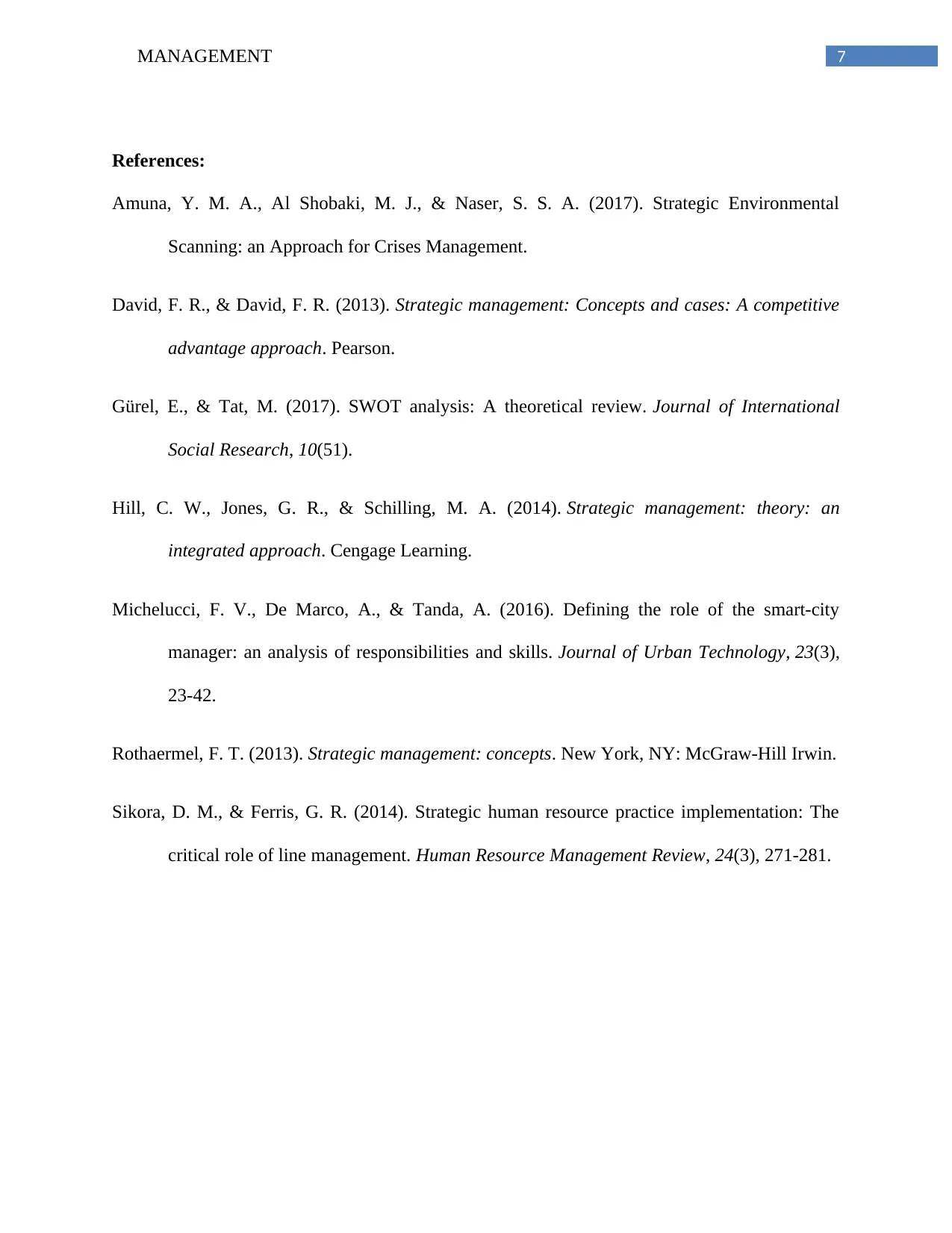
7MANAGEMENT
References:
Amuna, Y. M. A., Al Shobaki, M. J., & Naser, S. S. A. (2017). Strategic Environmental
Scanning: an Approach for Crises Management.
David, F. R., & David, F. R. (2013). Strategic management: Concepts and cases: A competitive
advantage approach. Pearson.
Gürel, E., & Tat, M. (2017). SWOT analysis: A theoretical review. Journal of International
Social Research, 10(51).
Hill, C. W., Jones, G. R., & Schilling, M. A. (2014). Strategic management: theory: an
integrated approach. Cengage Learning.
Michelucci, F. V., De Marco, A., & Tanda, A. (2016). Defining the role of the smart-city
manager: an analysis of responsibilities and skills. Journal of Urban Technology, 23(3),
23-42.
Rothaermel, F. T. (2013). Strategic management: concepts. New York, NY: McGraw-Hill Irwin.
Sikora, D. M., & Ferris, G. R. (2014). Strategic human resource practice implementation: The
critical role of line management. Human Resource Management Review, 24(3), 271-281.
References:
Amuna, Y. M. A., Al Shobaki, M. J., & Naser, S. S. A. (2017). Strategic Environmental
Scanning: an Approach for Crises Management.
David, F. R., & David, F. R. (2013). Strategic management: Concepts and cases: A competitive
advantage approach. Pearson.
Gürel, E., & Tat, M. (2017). SWOT analysis: A theoretical review. Journal of International
Social Research, 10(51).
Hill, C. W., Jones, G. R., & Schilling, M. A. (2014). Strategic management: theory: an
integrated approach. Cengage Learning.
Michelucci, F. V., De Marco, A., & Tanda, A. (2016). Defining the role of the smart-city
manager: an analysis of responsibilities and skills. Journal of Urban Technology, 23(3),
23-42.
Rothaermel, F. T. (2013). Strategic management: concepts. New York, NY: McGraw-Hill Irwin.
Sikora, D. M., & Ferris, G. R. (2014). Strategic human resource practice implementation: The
critical role of line management. Human Resource Management Review, 24(3), 271-281.
1 out of 8
Related Documents
Your All-in-One AI-Powered Toolkit for Academic Success.
+13062052269
info@desklib.com
Available 24*7 on WhatsApp / Email
![[object Object]](/_next/static/media/star-bottom.7253800d.svg)
Unlock your academic potential
Copyright © 2020–2025 A2Z Services. All Rights Reserved. Developed and managed by ZUCOL.





